How The Arizona Republic and the Phoenix Gazette covered the D-Day invasion as it unfolded
On June 6, 1944, Arizonans began following along as news broke of an Allied invasion on the beaches of Normandy.
There was quiet hope that the beginning of the end had arrived, but no overwhelming celebration, said Lora Key, managing editor of The Journal of Arizona History at the Arizona Historical Society.
“There wasn’t huge overjoy in that moment,” Key said.
As the invasion unfolded, Arizonans relied on newspaper and radio coverage for information. Many had lost contact with sons, husbands and others in the armed services in the weeks before D-Day, Key said, as soldiers cut off communication because of the potential for tactical information to be leaked.
D-Day was a turning point Americans had long anticipated, Key said. "The newspapers were constantly tracing the armies across the beaches," she said.
Here's how The Arizona Republic and the Phoenix Gazette covered D-Day and the first week of fighting that followed.
June 6, 1944
On Tuesday morning, June 6, 1944, The Arizona Republic published an Associated Press report declaring, "Allied troops began landing on the northern coast of France this morning strongly supported by naval and air forces."
The principal basis for the report was a communique from Gen. Dwight D. Eisenhower's headquarters, which was "read over a transatlantic hook-up" at 1:32 a.m. Phoenix time.
Although the Allied bulletin did not "say exactly where the invasion was taking place," the AP reported what it was hearing from German sources: "Berlin said the 'center of gravity' of the fierce fighting was a Caen ... 10 miles inland from the sea, at the base of the 75-mile-wide Normandy peninsula."
Under the subheading "Greatest Armada in History," the report continued:
"The great Allied armada dwarfed anything yet seen on the sea. Huge transport planes filled with paratroopers and pulling airborne troops in gliders roared over the German west wall to drop their cargos in the rear. Berlin said that masses of Allied parachute troops bailed out over Normandy, trying to seize airfields. Just before taking off in the darkness the paratroops were wished godspeed by the lanky Kansas supreme commander, General Eisenhower. He was accompanied by several other of his commanders and his face was tense but confident as he strode down the long lines of fighting men."
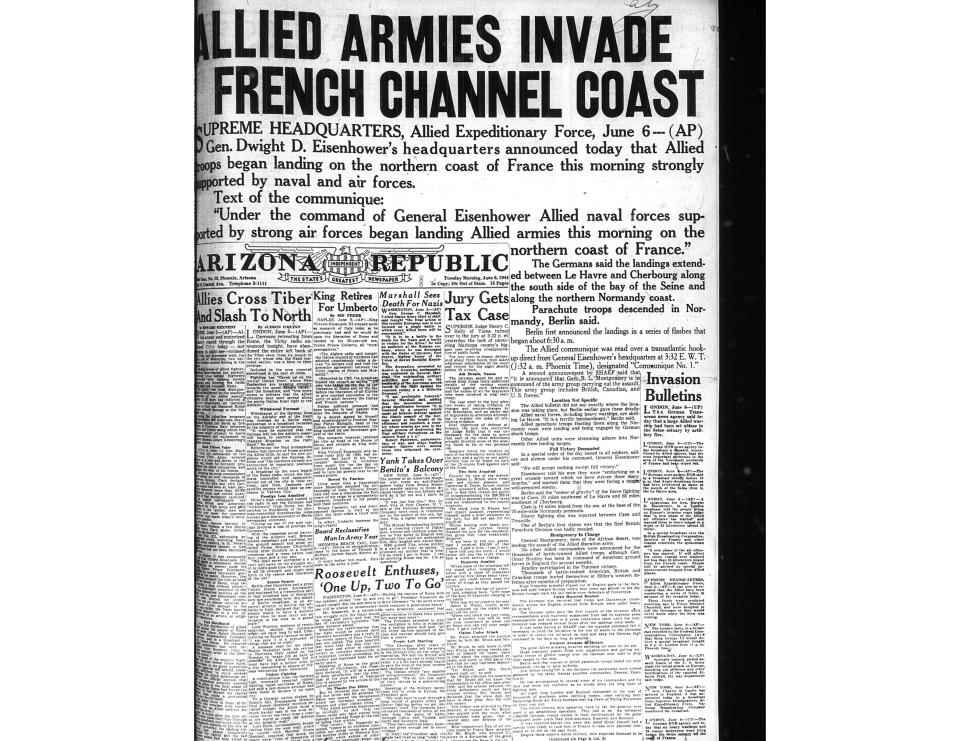
By the time the Phoenix Gazette's June 6 edition was released in the evening, additional details about the assault had emerged: "The initial landings were made from 6 to 8:25 a.m. British time (10 p.m. Monday to 12:25 a.m. Tuesday, Phoenix time). The Germans said subsequent landings were made on the English Channel isles of Jersey and Guernsey and that invasion at new points on the continent was expected hourly."
The front page was covered with dispatches about the invasion: The Russian army was "massing in preparation for another great attack from the East as its part in defeating Germany." Adolf Hilter was "rushing to France to try his intuition against the Allied operation." President Franklin D. Roosevelt "spent the early morning hours of the invasion writing a prayer for victory for the Allied forces of liberation." Prime Minister Winston Churchill "told a cheering House of Commons Tuesday that the Allied liberating assault upon Hitler's European stronghold was 'proceeding according to plan — and what a plan.'"
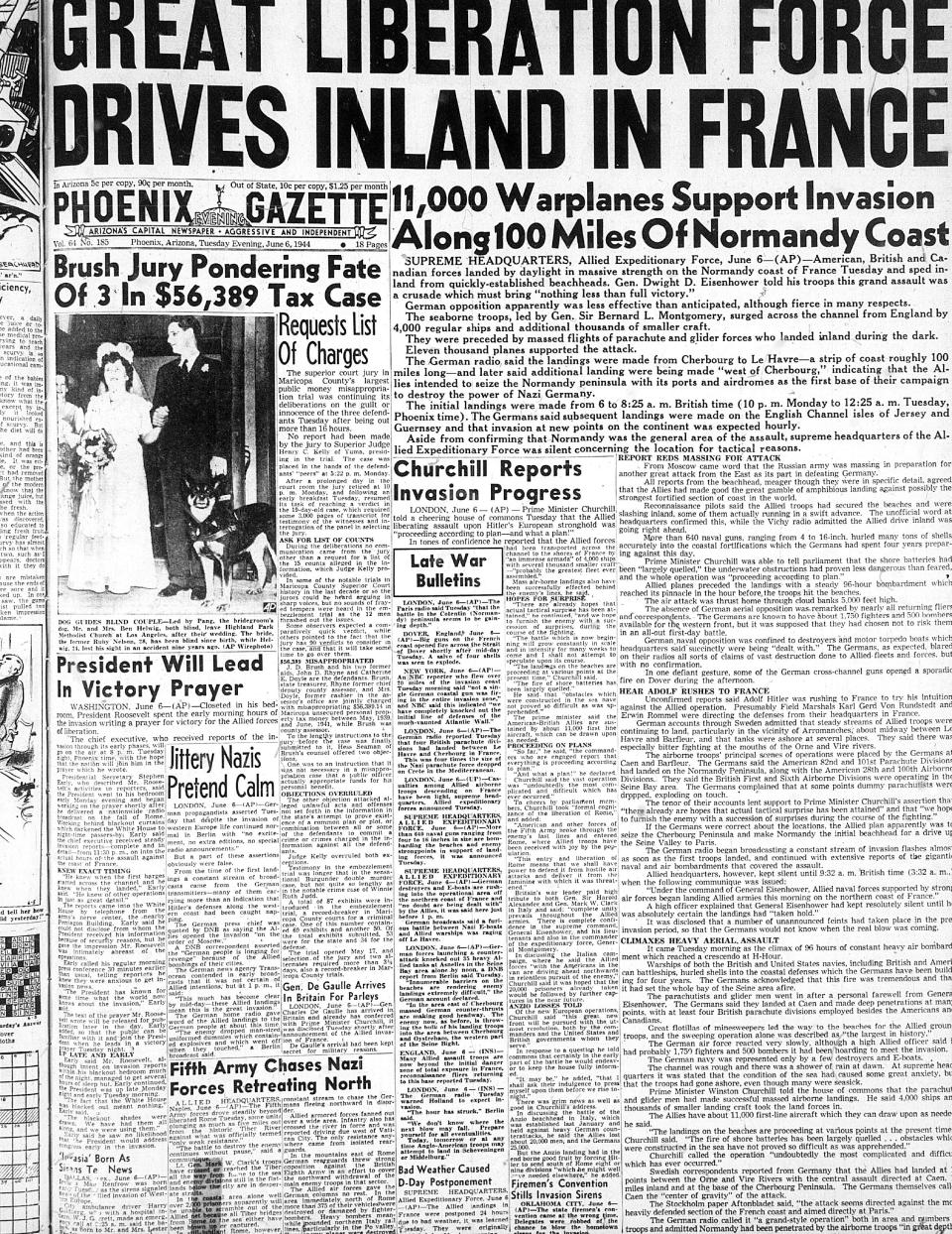
June 7, 1944
"Unfavorable weather — worse than in the Sicilian landings — was the chief Allied hazard," according to a dispatch from United Press journalist Edward W. Beattie published in The Republic. "The first German prisoners and Allied casualties were landed in England late yesterday — the wounded brought back by mine sweepers."
Beattie painted the scene of the D-Day landing for readers: "Under Gen. Sir Bernard L. Montgomery, the Allied troops — many of them seasick after their channel trip in bad weather — fought ashore through waist-deep mud and slime past underwater obstacles of concrete and wood, capped with deadly mines, to make good their landing against surprisingly light resistance."
An Associated Press report, also printed on The Republic's front page, quoted the prayer that Roosevelt finished "while American soldiers stormed the shores of France." The prayer, broadcast by radio, "asked for divine aid in the 'struggle to preserve our republic, our religion and our civilization, and to set free a suffering humanity.'"
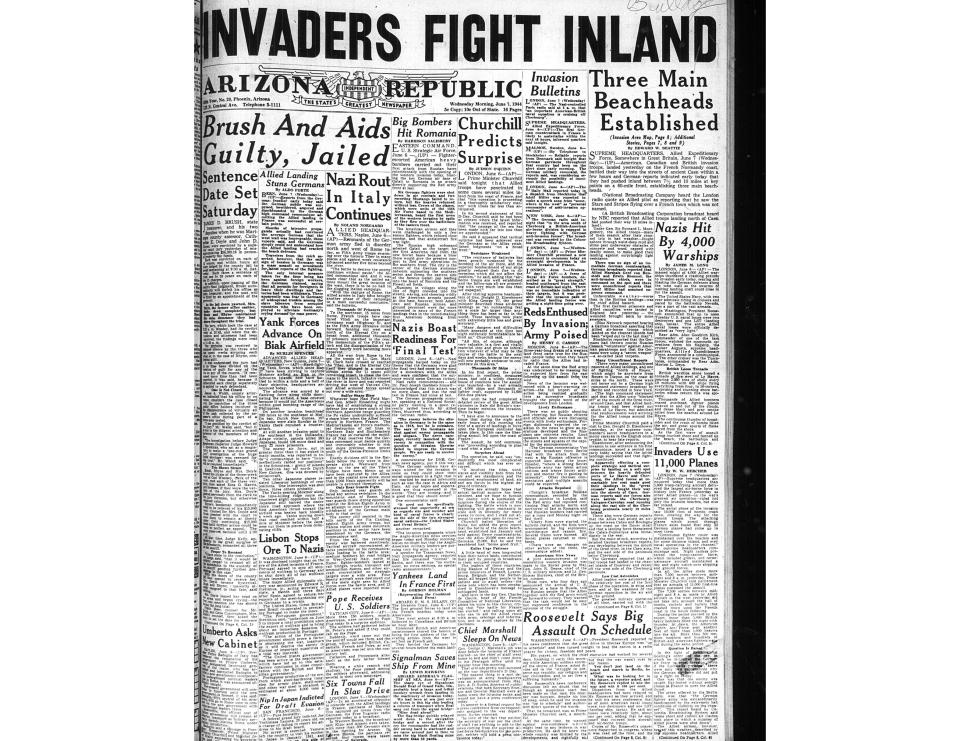
In the evening, the Phoenix Gazette reported on an American infantry unit that was "pinned to the beach by machine-gun fire before it could advance."
The paper also published a brief report saying "the German people were comparatively calm" but that they were astonished by the Allied invasion.
"Reports from the continent said Wednesday that the German people, pummeled for months with propaganda of the impregnability of the Nazi western wall, were bewildered and dumfounded by the news of the Allied landing in France," a United Press report said.
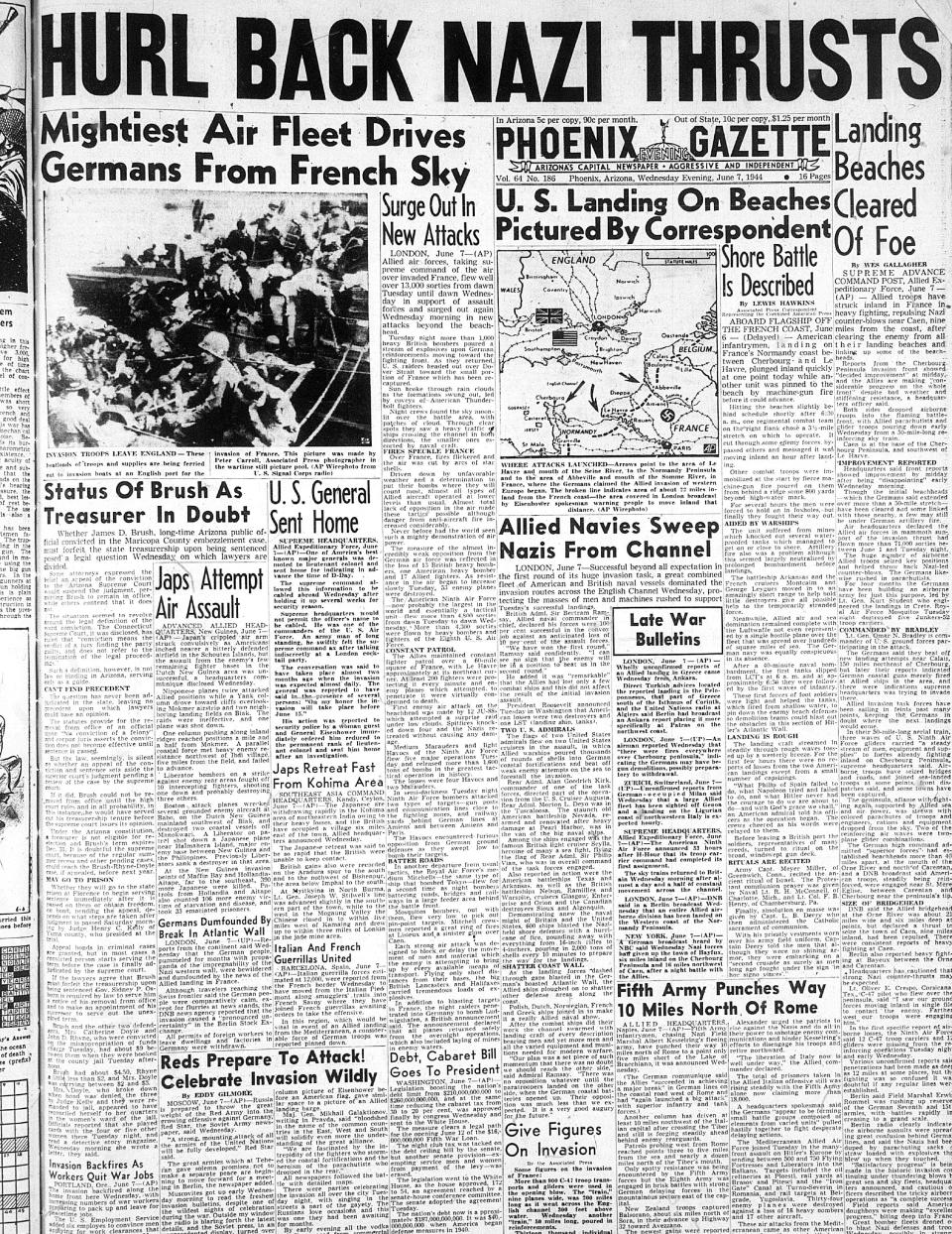
June 8, 1944
An unnamed United Press reporter embedded with Allied Expeditionary Forces provided this firsthand look at the invasion to Republic readers on June 8:
"Our forward troops, resting after snatching a few hours sleep last night are moving steadily forward against undiminished German resistance. We are on the outskirts of Caen and are joining up with the Canadians. A German tank counterattack has been smashed. The Luftwaffe is making desperate efforts to hold up our advance and there was constant bombing of the beach area last night. The skies were never without the roar of planes — usually mixed Allied and Focke-Wulfe German aircraft. We were witnesses to the arrival of a great air-borne army that landed last night. Literally hundreds of planes swept overhead, flying very low, and disgorged colored parachutes marking the different paratrooop units. The skies were filled with these bunches of colored silk unfolding like flowers. The German prisoners watched and were staggered by this manifestation of power."
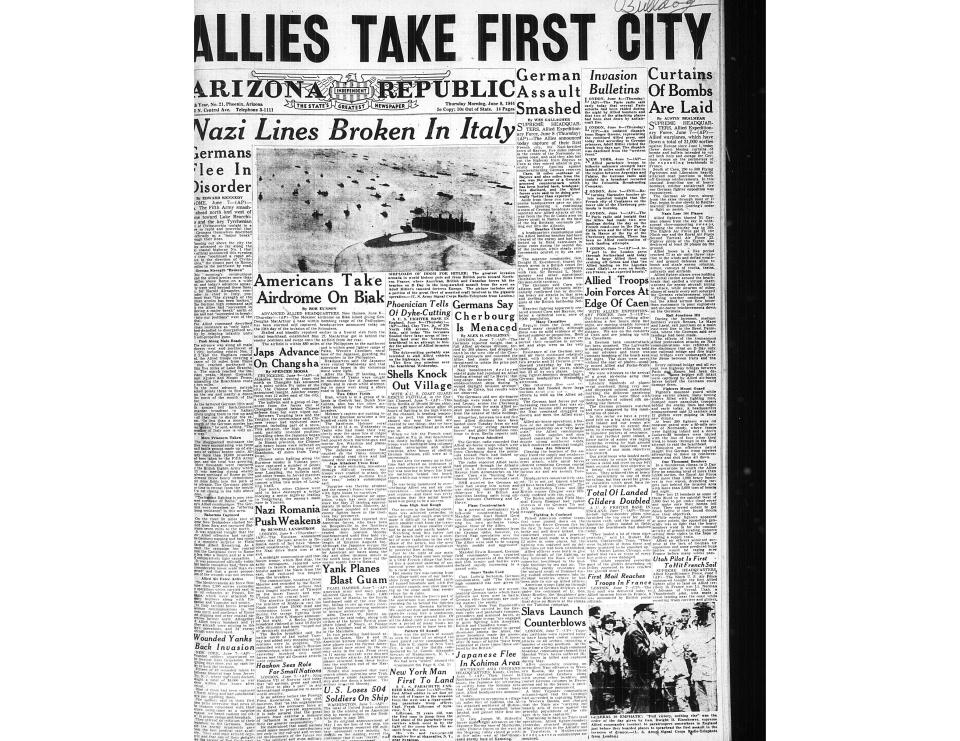
"The full weight of German counter-attack in Normandy is still to come, War Secretary (Henry) Stimson said Thursday, but invading Allied troops have established beachheads at various points between the mouth of the Seine and the Cotentin Peninsula, and some of these beachheads have been united," the Phoenix Gazette reported in the evening. The paper reported Stimson as saying, "It would be folly to believe that the period of counter-attack will be short."
The Gazette also provided what it calls "the first eye-witness dispatch from the first town in France to be liberated."
"I toured the Allied front in Normandy all day today and entered this historic town of Bayeux with the first Allied troops who occupied it at midday," reported United Press War Correspondent Richard D. McMillan. "It was a scene of rejoicing as the populace went wild and dashed through the narrow streets throwing flowers and crying, 'God save the king. We've waited for this day. On to Paris!'"
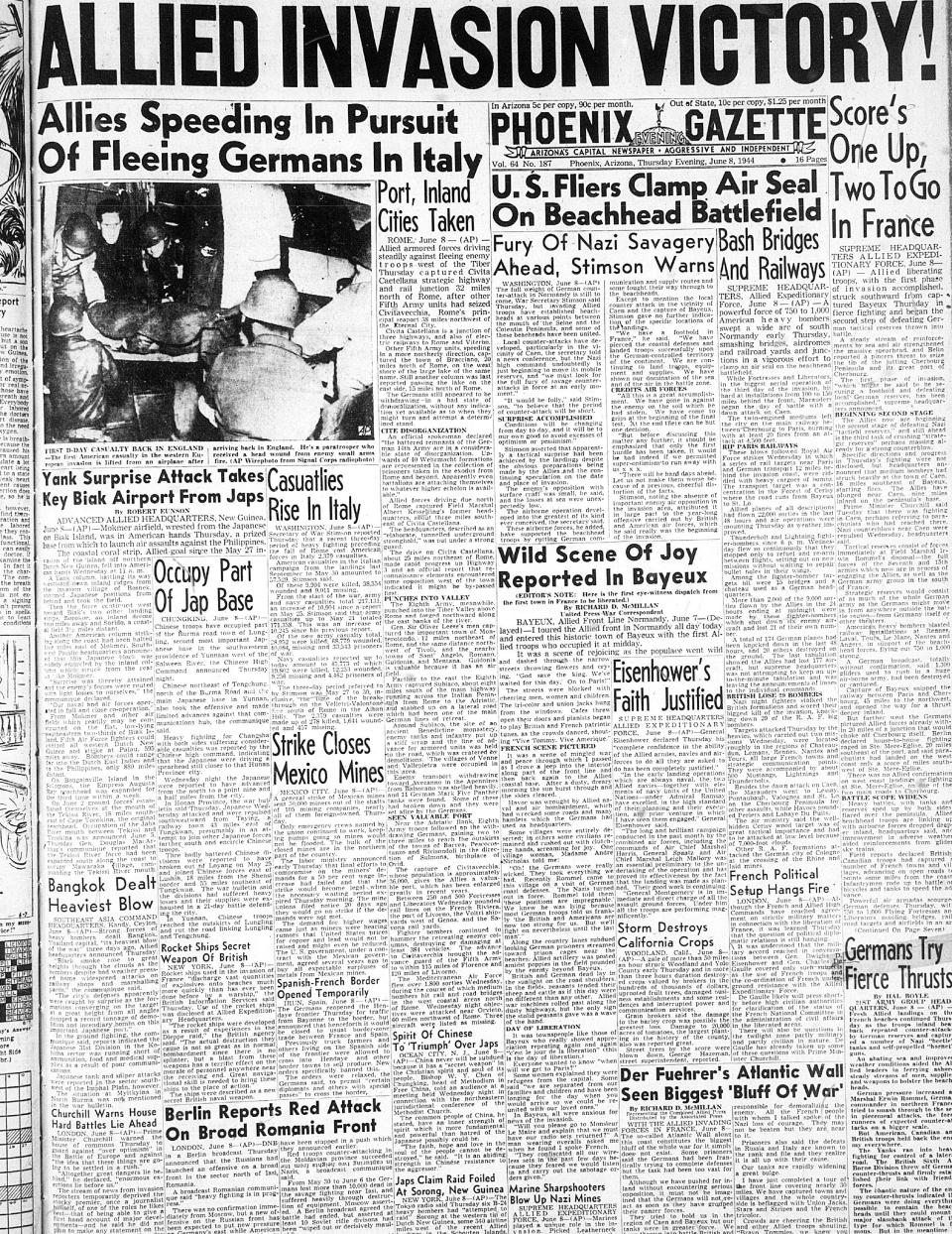
June 9, 1944
On the morning of Friday, June 9, The Republic featured a banner headline, "NAZIS FACE PENINSULA LOSS."
But a small story farther down the front page reminded readers of the war's human toll.
"The war, with no accounting yet of losses in the European coast landing, has cost the United States 217,131 casualties," the Associated Press reported. "On the basis of casualty reports in the past, it is not expected that losses in the battle of invasion will begin to be reflected in total reports for perhaps a fortnight."
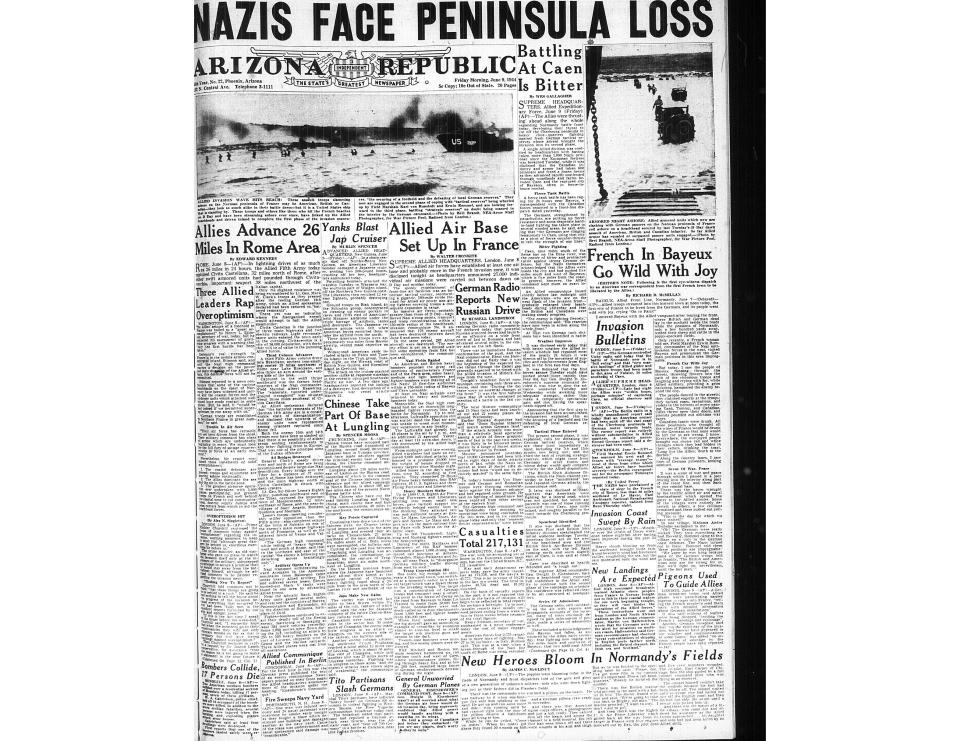
The Gazette that Friday featured three images from the invasion on the front page. The first was of the American battleship Texas: "The Texas was among more than 600 naval craft that tortured German positions and protected landings." The second showed a "U.S. Coast Guard landing boat approaching the French coast after German marchine-gun fire caused an explosion by setting off an American soldier's hand grenade." The third shows "German soldiers from beach fortifications taken by Canadian assault troops marching through Allied troops and equipment after their capture."
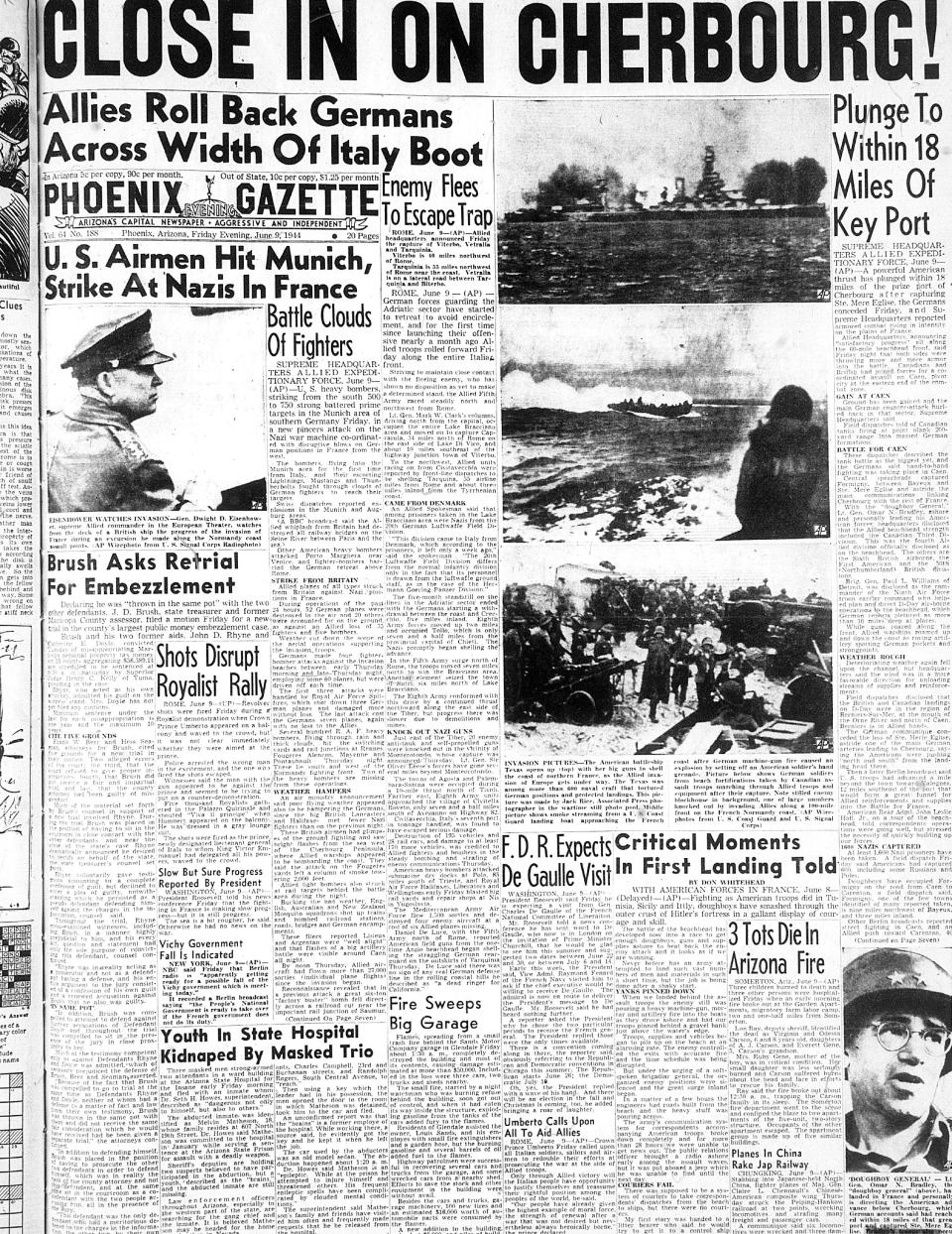
June 10, 1944
On Saturday morning, June 10, readers of The Republic awoke to the news that American, British and Canadian forces were "all making 'satisfactory progress' ... despite stiffening German resistance and ominously deteriorating weather that stopped virtually all air operations and hampered reinforcement of the beachheads."
Readers were also greeted with a story, "Nazi Radio Sees Belgium Assault Near," which reported that German broadcasts were predicting "the Allies would invade Belgium soon." Alongside the story were four X's and the note: "The Axis sometimes tries to slip propaganda to you through news ... so we will mark with the double cross all news we know comes from Axis sources."
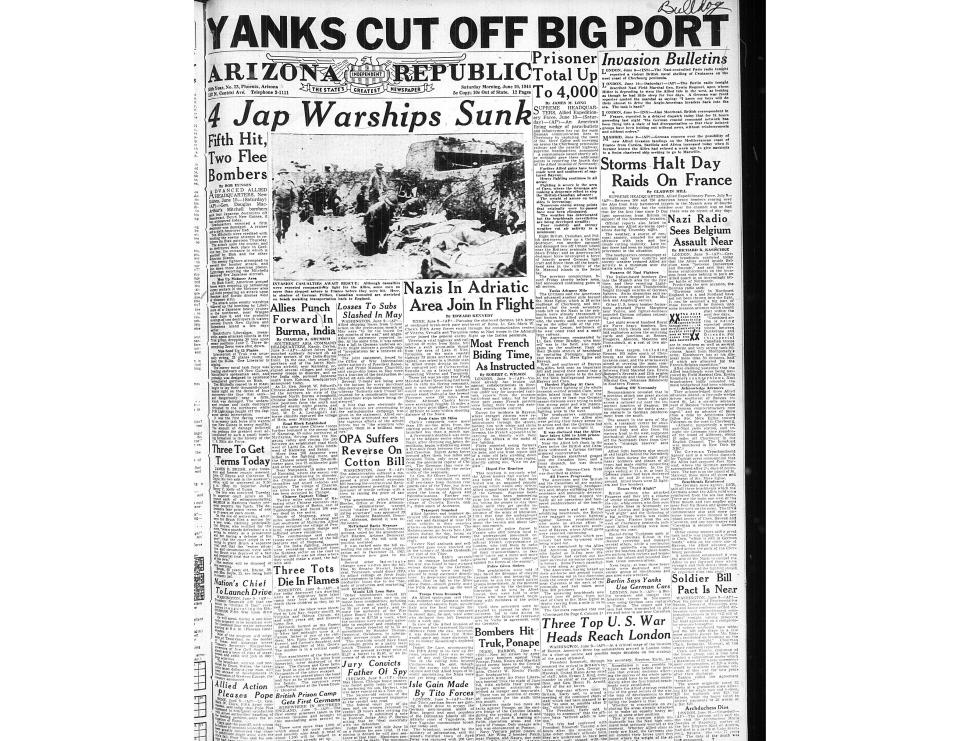
The Phoenix Gazette published a photo of dead soldiers on a beach that Saturday. "These are dead American soldiers — the first to hit the beach and to die on the invasion shores of northern France," the caption read. "These are American boys who gave their lives that the invasion might succeed."
The Gazette also reported that for the first time since 1940, Allied planes were operating from French soil.
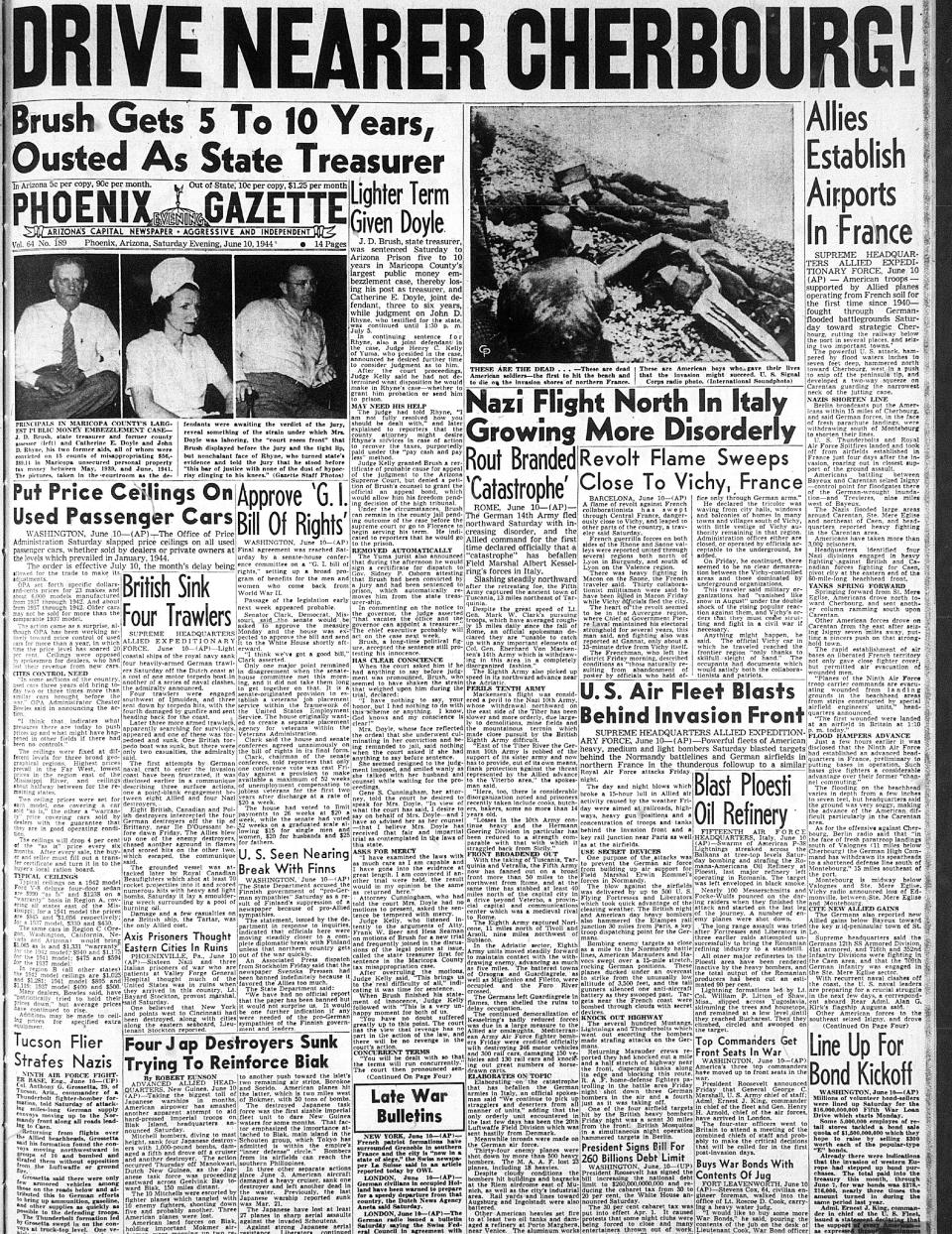
June 11, 1944
"U.S. troops smashed a third of the way across the Normandy peninsula yesterday in a drive to seal off the prize port of Cherbourg and captured two towns and a handful of villages under cover of Allied fighters striking from newly seized airfields in France," Associated Press reporter James M. Long reported to readers of The Republic on Sunday, June 11. The breathless report continued: "The Americans under Lt. Gen. Omar N. Bradley captured the small but valuable port of Isigny, 32 miles southeast of Cherbourg, toppled Trevieres, eight miles west of Isigny, and slashed 'in several places' the main Paris railway leading into Cherbourg."
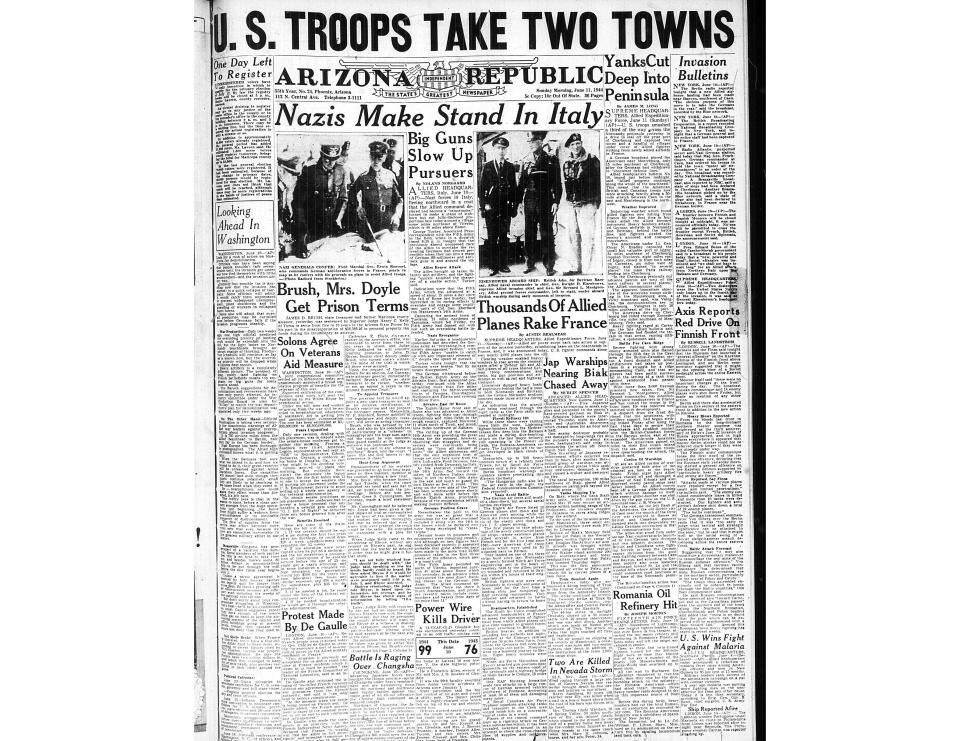
June 12, 1944
On the Monday following the D-Day landing, The Republic reported that the command headquarters of the invasion — Supreme Headquarters, Allied Expeditionary Force — said that American troops were making progress that was "excellent — it could not be better."
The paper also published a brief saying that "the British disclosed tonight that a 'secret weapon' used in the Normandy landings was a huge new glider called the Hamilcar."
The Hamilcar, the report said, "must be towed by a heavy bomber, but can land in a small field. It can — and did — carry a light tank."
"One of the first tanks to be landed in France silenced within two minutes a German gun post which had been causing heavy casualties among Allied ground forces," the Associated Press report said. "Another Hamilcar's tank immediately blew the top off a tower in which German snipers were concealed."

The caption of an image on the front page of the Phoenix Gazette recalled the trench warfare of the Great War: "YANKS GO OVER THE TOP AGAIN IN FRANCE — Sons of American doughboys who 26 years ago 'went over the top' in France during battles of World War I, repeat with a charge over the top in new battles against the Germans in World War II in northern France. Other troops wait beside a wall for their order to go into action."

June 13, 1944
A week after D-Day, readers of The Republic's front page were told that Allied forces were "battling Nazi forces only 14 miles from the prize port of Cherbourg."
Allied headquarters, in its 14th communique since the invasion began, declared more positive news: "The fusion of our beachhead is now complete and a coastal strip some 60 miles long is firmly in our hands. Its depth is being increased steadily."
Lower on the page was a photo of a young boy smiling in a Phoenix pool, a reminder that Phoenix's summer was proceeding with some normalcy: "WATER'S FINE: 'Come on in!' this smiling youngster seems to be saying as he gets the 'feel' of the pool at the start of his first lesson in the Arizona Republic-Young Men's Christian Association-Phoenix Parks and Playgrounds Department free Learn-to-Swim campaign now under way in four Phoenix pools and to be extended next week to Tempe, Mesa and Glendale pools."
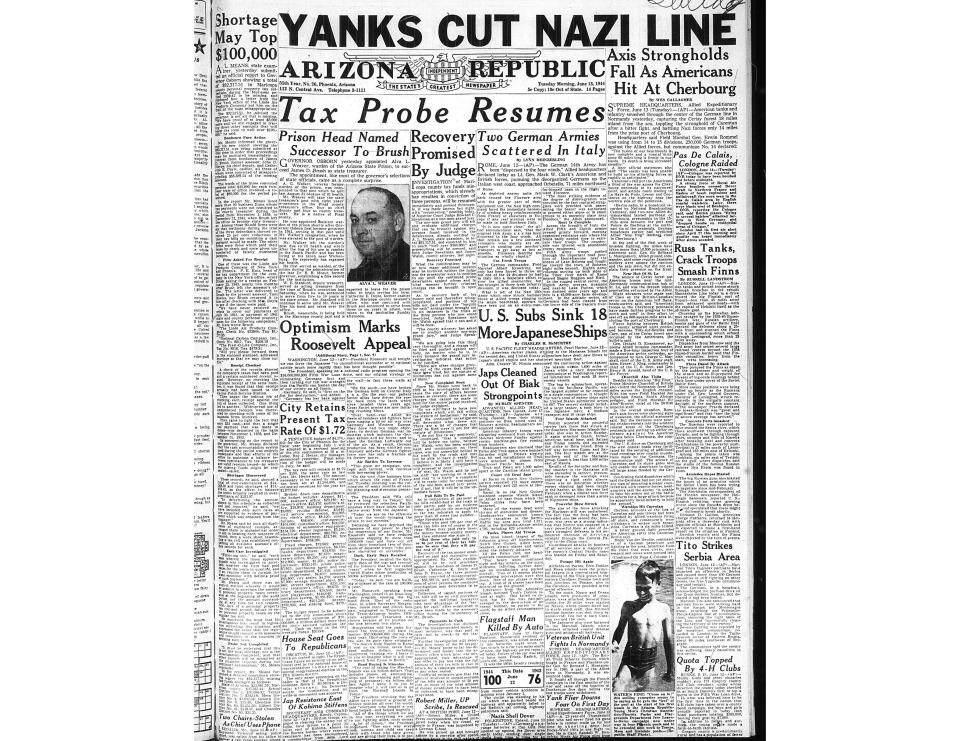
This article originally appeared on Arizona Republic: How The Arizona Republic covered D-Day as the invasion unfolded

 Yahoo Autos
Yahoo Autos 